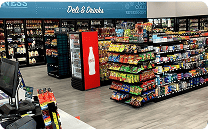In This article
Gamification refers to the strategic application of game mechanics in non-game environments to encourage specific behaviors, increase engagement, and foster motivation. In business and industrial settings, particularly those that involve complex operations or critical security protocols, gamification offers a novel way to align human behavior with organizational goals by making routine tasks more engaging and measurable.
Though it might seem unrelated at first glance, gamification has growing relevance in security and surveillance. When paired with security camera systems and workplace monitoring tools, it can be used to:
- Promote safety awareness
- Enhance employee compliance with protocols
- Incentivize participation in service-related activities
- Encourage proactive behaviors such as hazard reporting or checklist completion
Practical Applications of Gamification
In the workplace context, gamification can be layered into systems that already collect data through security cameras or access control systems. For example:
- Safety Compliance Leaderboards: Organizations can create dashboards that rank employees, teams, or departments based on their adherence to safety protocols, such as wearing PPE, following secure entry procedures, or completing regular safety drills.
- Incident Reporting Challenges: Employees may be rewarded with points or digital badges for submitting security or safety observations, such as reporting a suspicious person or flagging a potential access control violation.
- Training Engagement: Gamification is particularly effective in security awareness training. Employees who complete training modules, pass quizzes, or interact with video-based simulations (sometimes recorded or reviewed through surveillance footage) can earn recognition, rewards, or professional development points.
- Behavioral Feedback Loops: With AI-driven video analytics and cloud-based surveillance platforms, businesses can analyze behavior patterns (e.g., how employees navigate restricted areas) and tie compliance to game-like feedback systems that encourage continuous improvement.
How AI and Security Cameras Enable Gamification
Modern security camera systems with AI and behavioral analytics make gamification more actionable. These systems can automatically track compliance metrics, detect rule violations, and even integrate with workplace apps or training platforms. For example, if a surveillance camera detects that an employee repeatedly fails to wear required safety gear, this could be reflected in a gamified dashboard that highlights areas for improvement.
Conversely, consistent compliance could result in digital recognition or tangible incentives, such as monthly rewards for the “most compliant team” or “quickest incident responder.” This approach transforms passive monitoring into a proactive engagement strategy.
Benefits and Considerations
Gamification can lead to measurable improvements in:
- Workplace safety and security behaviors
- Training, retention, and participation rates
- Employee morale and team accountability
- Organizational culture around vigilance and compliance
Successful gamification requires careful design. Poorly implemented systems can feel punitive, encourage competition at the expense of collaboration, or result in metric-chasing behaviors that undermine broader goals. Transparency, fairness, and meaningful rewards are essential to building trust and ensuring participation.
Gamification also must comply with privacy and labor regulations, especially if tied to camera footage or personal performance data. Any use of surveillance in a gamified system should be clearly communicated and aligned with company policies.
The Bigger Picture
Ultimately, gamification isn’t about turning work into a game — it’s about borrowing game mechanics to enhance motivation, accountability, and learning. For industries where vigilance and compliance are critical but often overlooked, gamification offers a creative way to keep these goals top-of-mind — and to do so with measurable impact.
Turn Engagement into Action with DTiQ
Gamification isn’t just about points and badges—it’s about motivating better decisions, behaviors, and outcomes. DTiQ brings this philosophy into the drive-thru with its dynamic ranking system. Comparing QSRs‘ efficiency with their peers across the brand, franchisee, region, or even custom groups provides unparalleled insights for improving speed and service. DTiQ helps you build a culture of accountability and engagement, powered by the same principles that make gamification so effective. To learn more, visit our website.





























